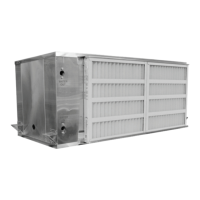35
on the control board. The higher fan speed
is achieved by connecting Y from the
thermostat to Y2 on the control board.
Motor Tap RPMs
RPM PSC Tap
Note: RPMs are approximate, and will vary
slightly depending on TSP across the blower
assembly
For unit operation at ISO 13256-1 rating
conditions, PSC blower motors must use
“High” Speed and 8. B through E cabinet
unit (WH015-060) ECM blower motors
must use speed tap 4. WH ½ - 1 ton units
may also require specific dip-switch
settings. Please consult factory for details.
Filters
Do not operate the unit without filters in
place. Unit must be checked for correct filter
placement during startup. Operation of the
equipment without filters will result in a
clogged air coil.
Adjusting Refrigerant Charge
Unit must be operating in the cooling mode to
adjust the refrigerant charge.
Adjusting the charge of a system in the field
must be based on determination of liquid
sub-cooling and evaporator superheat. On a
system with a TXV liquid sub-cooling is
more representative of the charge than
evaporator superheat but both measurements
must be taken.
Before Charging
Unit being charged must be at or near full
load conditions before adjusting the charge.
Units equipped with hot gas reheat must be
charged with the hot gas reheat valves
closed while the unit is in cooling mode to
get the proper charge. After charging,
operate the unit in reheat (dehumidification)
mode to check for correct operation.
After adding or removing charge the system
must be allowed to stabilize, typically 10-15
minutes, before making any other
adjustments.
The type of unit and options determine the
ranges for liquid sub-cooling and evaporator
superheat. Refer to the tables below when
determining the proper sub-cooling.
Checking Liquid Sub-Cooling
Measure the temperature of the liquid line as
it leaves the refrigerant-to-water heat
exchanger.
Read the gauge pressure at the liquid line
close to the point where the temperature was
taken.
Before completing startup and
leaving the unit a complete operating
cycle must be observed to verify that
all components are functioning
properly.
Due to the charge-critical nature of
these units, charge must
only be
adjusted if absolutely necessary.

